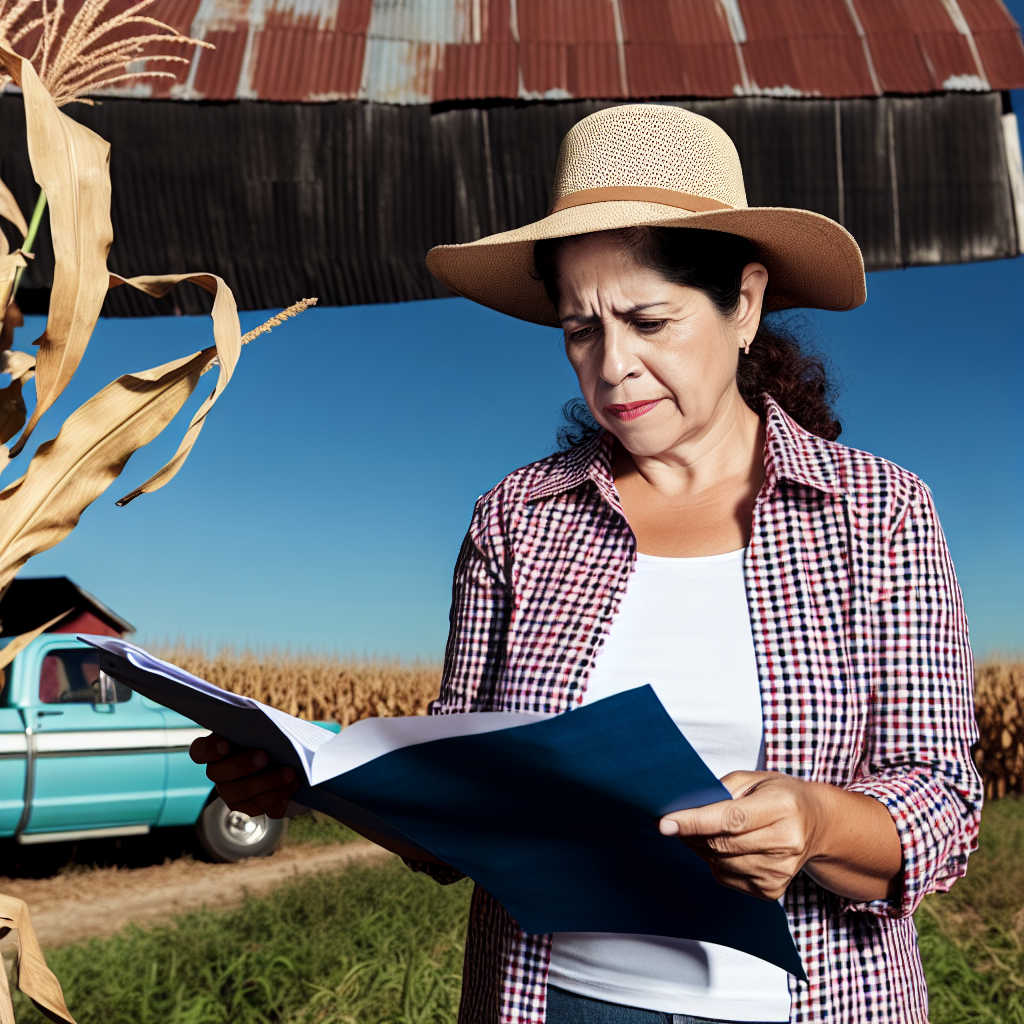Introduction to Agricultural Insurance and Its Importance for Farmers
Agricultural insurance protects farmers against unexpected losses.
This type of insurance is vital for sustainable farming.
It provides financial support during adverse events.
Farmers face various risks, including weather, pests, and market fluctuations.
These risks can severely impact their livelihoods.
A strong insurance policy mitigates these risks effectively.
Understanding Agricultural Insurance
Agricultural insurance falls into several categories.
These include crop insurance, livestock insurance, and farm property insurance.
Each type serves a specific purpose for farmers.
Moreover, policies can be tailored to individual needs.
The Role of Agricultural Insurance in Risk Management
Insurance plays a crucial role in risk management for farmers.
It allows them to recover quickly from unforeseen losses.
Consequently, they can maintain their operations effectively.
This reliability fosters more robust agricultural practices.
Benefits of Having Agricultural Insurance
Having agricultural insurance presents numerous benefits.
Transform Your Agribusiness
Unlock your farm's potential with expert advice tailored to your needs. Get actionable steps that drive real results.
Get Started- It secures financial stability during adverse conditions.
- Farmers can access loans more easily with insurance coverage.
- Insurance encourages investment in growth and innovation.
- It promotes peace of mind for farmers and their families.
Challenges Farmers Face Without Insurance
Farmers without insurance face significant challenges.
They bear the full financial burden of crop failures.
This situation can lead to heavy debts and loss of assets.
Additionally, it may deter potential new farmers from entering the field.
Implications of Agricultural Insurance for Farmers
In light of these points, agricultural insurance emerges as essential.
Farmers must educate themselves about available options.
Ultimately, robust policies offer security and peace of mind.
Types of Agricultural Insurance Policies Available for Farmers
Crops Insurance
Crops insurance protects farmers against losses from natural disasters.
This insurance typically covers crops from floods, droughts, and pests.
Farmers can choose between actual production history or revenue protection policies.
Moreover, it provides coverage for unexpected weather events that could damage yields.
Livestock Insurance
Livestock insurance safeguards farmers’ investments in their animals.
This type of insurance covers losses due to deaths, injuries, or theft.
Farmers can also insure against disease outbreaks affecting their herd.
Additionally, specific policies exist for different livestock types, like cattle or poultry.
Farm Equipment Insurance
Farm equipment insurance offers coverage for tractors and other machinery.
This insurance protects against theft, damage, or loss due to accidents.
Farmers need to assess the value of their equipment to determine adequate coverage.
This kind of insurance often includes options for replacement and repair costs.
Liability Insurance
Liability insurance protects farmers from legal claims by third parties.
This insurance covers accidents that may occur on the farm property.
It is essential for farmers who have visitors or customers on their property.
Additionally, some policies offer coverage for product liability if selling goods.
Multi-Peril Insurance
Multi-peril insurance combines several types of coverage into one policy.
Showcase Your Farming Business
Publish your professional farming services profile on our blog for a one-time fee of $200 and reach a dedicated audience of farmers and agribusiness owners.
Publish Your ProfileThis policy simplifies protection against multiple risks faced by farmers.
Farmers can select various perils to include, depending on their unique needs.
Overall, it provides comprehensive coverage for various agricultural hazards.
Importance of Understanding Policy Options
Farmers should evaluate their specific needs before selecting policies.
Understanding available options helps ensure adequate coverage.
This knowledge can protect against future financial losses due to unforeseen events.
Key Requirements for Obtaining Agricultural Insurance
Eligibility Criteria
Farmers must meet specific eligibility criteria for agricultural insurance.
These criteria often include owning or renting farmland.
Additionally, farmers should have a documented history of agricultural production.
Insurance providers also require applicants to maintain accurate records.
These records help assess the risk associated with the farm operation.
Types of Insurance Policies
Understanding different types of agricultural insurance is crucial.
Farmers can choose from several policy options.
Cropped insurance protects against yield loss due to unforeseen events.
Livestock insurance covers losses from animal deaths or theft.
Property insurance safeguards buildings and machinery on the farm.
Documentation Requirements
Farmers need to provide various documents to obtain insurance.
Proof of identity is a fundamental requirement.
Additionally, farmers must submit financial statements.
These statements illustrate the farm’s income and expenses.
Insurance companies often require farm management practices documentation as well.
Application Process
The application process for agricultural insurance can vary.
Farmers typically start by contacting an insurance agent.
The agent will guide them through the necessary steps.
Online applications are increasingly common for convenience.
Submitting all required documents ensures a smoother process.
Premiums and Deductibles
Understanding the cost structure of premiums and deductibles is essential.
Farmers should assess their budget when selecting a policy.
Premium costs can vary based on the type and amount of coverage.
Additionally, farmers should consider what deductible they can afford.
A higher deductible often results in lower premium costs.
Uncover the Details: Implementing Effective Animal Welfare Policies on Your Farm
Documentation Needed for Agricultural Insurance Applications
Basic Information
Farmers must provide basic farm details when applying.
This includes the name of the farm and its location.
Additionally, applicants should include their contact information.
Farm Operation Details
Farmers are required to describe their farming operations.
This includes the type of crops grown or livestock raised.
Moreover, farmers must share the size of their farming operations.
Typically, this is measured in acres or livestock units.
Financial Records
Farmers need to submit financial documentation.
Showcase Your Farming Business
Publish your professional farming services profile on our blog for a one-time fee of $200 and reach a dedicated audience of farmers and agribusiness owners.
Publish Your ProfileTax returns from the previous years can serve this purpose.
They should also provide profit and loss statements.
These documents help insurers assess the farm’s financial health.
Inventory Records
It’s important for farmers to maintain accurate inventory records.
Farmers must provide a list of insured items.
This could include livestock, equipment, and crops.
Additionally, documenting the value of these assets is essential.
Prior Insurance Information
Farmers should disclose any prior insurance policies.
Insurers will want to know the details of previous coverage.
This includes the types of coverage and claims made.
Such information aids in determining current needs and risks.
Risk Management Plan
A risk management plan is often beneficial for applications.
This plan outlines strategies to minimize potential losses.
Farmers should detail their approach to managing risks.
Such plans enhance credibility and support applications.
Local Regulations and Compliance
Farmers must be aware of local agricultural regulations.
Compliance documentation may be required in applications.
This ensures that farms operate within legal guidelines.
Additionally, certifications related to farm practices may be necessary.
Submitting the Application
Farmers should carefully review their applications before submission.
Ensure all required documents are complete and accurate.
Missing information can delay the insurance process.
Once everything is in order, submit the application to the insurer.
See Related Content: Agricultural Land Use and Zoning Laws
Understanding Risk Assessment in Agricultural Insurance
The Importance of Risk Assessment
Risk assessment plays a crucial role in agricultural insurance.
It identifies potential losses farmers may face each crop season.
By understanding these risks, farmers can make informed decisions.
Additionally, risk assessment helps insurers determine appropriate coverage.
Types of Risks in Agriculture
A variety of risks impact agricultural production.
- Weather events, such as droughts or floods, are significant threats.
- Pest infestations can lead to crop damage and loss.
- Market fluctuations can influence the prices of agricultural products.
- Economic changes, including inflation or shifts in consumer demand, can affect profitability.
Conducting a Risk Assessment
Farmers should begin by evaluating their specific farming practices.
This includes considering the crops grown, farming techniques used, and local climatic conditions.
Moreover, they must gather historical data on past losses.
Such information aids in predicting future risks more accurately.
Working with Insurance Agents
Collaboration with knowledgeable insurance agents is essential.
These professionals understand the nuances of agricultural insurance.
They can offer tailored advice based on the farmer’s unique situation.
Consequently, farmers can select policies that best suit their needs.
Benefits of Proper Risk Assessment
A comprehensive risk assessment fosters better risk management strategies.
It allows farmers to secure appropriate insurance coverage.
Furthermore, it helps them prepare for unforeseen challenges.
Showcase Your Farming Business
Publish your professional farming services profile on our blog for a one-time fee of $200 and reach a dedicated audience of farmers and agribusiness owners.
Publish Your ProfileUltimately, this proactive approach safeguards their livelihoods.
You Might Also Like: Integrated Pest Management Guidelines

Common Exclusions and Limitations in Agricultural Insurance Policies
Understanding Exclusions
Exclusions refer to specific situations or conditions not covered by insurance policies.
Farmers must understand these exclusions to avoid surprises at the time of a claim.
Frequently, policies exclude damage caused by natural disasters like floods and earthquakes.
This limitation can leave farmers vulnerable during extreme weather events.
Moreover, certain policies do not cover mechanical breakdowns of farming equipment.
Limitations on Coverage Amounts
Insurance policies often impose limits on the amount of coverage available.
For instance, a policy may cap the payout at a percentage of the insured value.
This can lead to significant financial loss in case of substantial damage.
Farmers should examine these limits carefully when selecting their insurance options.
Specific Crop and Livestock Exclusions
Many agricultural insurance policies exclude coverage for specific crops or livestock.
Certain high-risk crops may not receive coverage due to their vulnerability to pests.
Additionally, rare breeds of livestock might not be included in standard policies.
Exclusions Related to Negligence
Policies commonly exclude damages resulting from negligence on the farmer’s part.
For example, failure to maintain equipment may void an insurance claim.
Farmers must ensure they adhere to all maintenance guidelines to avoid this risk.
Other Considerations
It’s essential to understand that many insurance policies contain specific reporting requirements.
Failure to report incidents promptly can result in denied claims.
Additionally, some policies may not cover losses from theft or vandalism.
Consequently, farmers should consider supplementary security measures to mitigate these risks.
Explore Further: Food Safety Compliance Strategies for Small Farmers
The Role of Government Programs in Supporting Agricultural Insurance
Introduction to Government Support
Government programs play a crucial role in agricultural insurance.
They provide financial assistance and resources to farmers.
Program objectives include stabilizing income and reducing risk.
Types of Government Programs
Several types of government programs support agricultural insurance.
- Direct subsidies help lower insurance costs for farmers.
- Reinsurance programs mitigate the risk for private insurers.
- Education and outreach programs inform farmers about options.
Subsidy Programs and Their Impact
Subsidy programs significantly lower insurance premiums for farmers.
For instance, the Federal Crop Insurance program offers premium discounts.
These discounts make it easier for farmers to obtain necessary coverage.
Collaboration with Private Insurers
Government programs often collaborate with private insurers.
This partnership encourages competition in the insurance market.
Consequently, farmers have better access to diverse insurance options.
Importance of Education and Outreach
Education programs raise awareness about available insurance options.
Workshops and seminars help farmers understand policy requirements.
As a result, informed farmers can make better decisions about coverage.
Enhancing Agricultural Resilience through Government Support
Government programs greatly enhance agricultural insurance.
They provide financial support, collaborate with insurers, and educate farmers.
These efforts build a more resilient agricultural sector.
Steps for Filing a Claim under an Agricultural Insurance Policy
Initial Claim Assessment
Start by reviewing your agricultural insurance policy details.
Identify the specific coverage and conditions outlined in the policy.
Showcase Your Farming Business
Publish your professional farming services profile on our blog for a one-time fee of $200 and reach a dedicated audience of farmers and agribusiness owners.
Publish Your ProfileCheck for any claim exclusions relevant to your situation.
Document the event that caused the loss or damage.
Gather Supporting Documentation
Collect all relevant evidence related to the claim.
This may include photographs of the damage or loss.
Obtain records of financial losses caused by the event.
Gather any witness statements if applicable.
Contact Your Insurance Provider
Reach out to your agricultural insurance provider promptly.
Inform them of the incident that led to the claim.
Provide a brief overview of the situation and your collected documentation.
Complete the Claim Form
Your insurance provider will send you a claim form.
Fill out the claim form accurately and thoroughly.
Include all necessary details and documentation.
Submit the Claim
Once completed, submit the claim form to your insurance provider.
Consider using certified mail for proof of submission.
Keep copies of everything you send for your records.
Follow Up on the Claim Status
Stay in touch with your insurance adjuster for updates.
Be proactive in following up if you don’t hear back.
Ask for an estimated timeline for processing your claim.
Additional Resources
Farm & Commodity Policy | Economic Research Service
H.R.2642 – 113th Congress (2013-2014): Agriculture Reform, Food …




